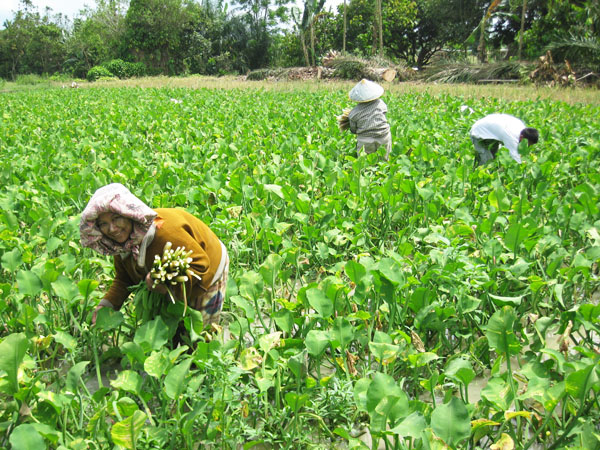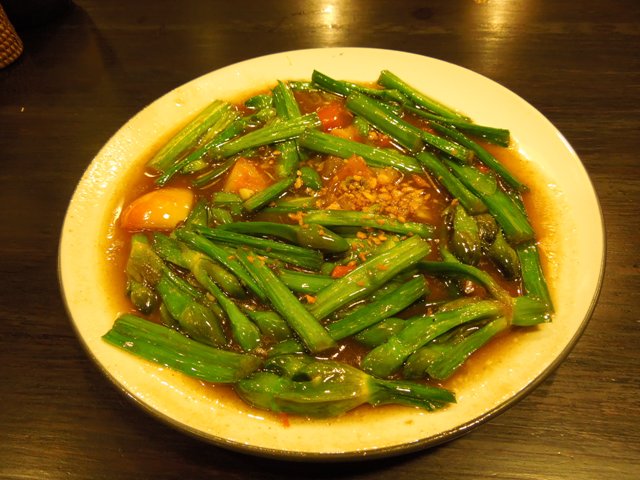|
“The vegetable genjer? It’s been a really long time since I’ve tasted it,” said Mbah Sukri, a 69-year-old retired textile factory worker from the Sleman area of Jogjakarta. Reminded of the vegetable of her youth, she began to wax nostalgic about going out to pluck genjer along the narrow banks between the paddy fields where the young rice shoots grow. Returning home, she would give her bundles of genjer to her grandmother to cook. “If you want my opinion, genjer is best when it’s stir-fried, served plain or with chili peppers. But neither the stalks nor the leaves should be chopped, just squeezed and kneaded with the fingers. I guarantee you, it tastes better that way,” she advised.
 Genjer harvest
Mbak Sukri is one of only a few Indonesians still familiar with the taste of genjer and the techniques of cooking it. For this humble green plant became far more than a mere vegetable. During the tumultuous history of 20th century Indonesia, genjer became a symbol of suffering and oppression, of political triumph and tragedy, and finally of the freedom to choose what one wishes for one’s dining table.
 Genjer dish
Genjer (Limnocharis flava) is a wild-growing green, but unlike its cousins kangkung, semanggi and bopong, which look and taste similar, genjer only grows well in very moist soil. Genjer thrives in river valleys, along banks of loose soil or mud covered with shallow water, and in paddy fields that are still filled with water after the harvest or have just been irrigated for planting. Genjer leaves are rounded, and in fertile areas they can grow as wide as the palm of a human hand, supported on three-sided, hollow stalks. Javanese sometimes call the plant enthongan, because a stalk and leaf looks a bit like a large spoon or scoop.
 Fresh Genjer
In the early 20th century, genjer was rarely considered fit for human consumption. In East Java its leaves and stalks were sometimes stir-fried or mixed with grated coconut into an urap salad, and in Central Java it was sometimes served with rice and pecel peanut sauce. Most Indonesians, however, saw genjer as little more than livestock feed. “Genjer became the food of the poor who were desperate for food during the Japanese occupation,” Mbah Sukri explained. “Before that, genjer used to just be chopped up and mixed with rice bran to feed the cows and goats.” During the three years of the Japanese occupation, from 1942 to 1945, many Indonesians found themselves destitute, and they were forced to eat genjer just to put something in their stomachs. Genjer was usually prepared as a side dish to accompany Gatotkaca or Anjasmara. Gatotkaca was a fancy name given to cassava, while Anjasmara was leftovers that had been preserved by setting them out in the sun to dry before boiling them up for a second time around. As an extra, grilled snails were often added to the dish, which supposedly helped to prevent the bloating associated with malnutrition.
Today genjer not only triggers memories of hard times and famine, but of a song that became a top hit in the early 1960s. “Genjer-genjer” was a song of praise for this humble vegetable, in three Javanese-language verses. It was a song about the “little people” and their everyday struggle to make ends meet. But if its roots were populist, the song soon became embroiled in party politics when members of the Indonesian Communist Party (PKI) decided to make it an emblem of their ideology. In the 1960s, the song “Genjer-genjer” became an anthem of the PKI, while another well-known song entitled “Turi-turi Putih” (“White Flowers”) was known as the song of the rival Indonesian Nationalist Party (PNI).
A song
The lyrics of “Genjer-genjer” are in Javanese, and there are slight variations in dialect from one region to the other. One of the best-known versions is as follows:
Gendjer-gendjer neng ledokan pating keleler
Gendjer-gendjer neng ledokan pating keleler
Emake thole teka-teka mbubuti gendjer
Emake thole teka-teka mbubuti gendjer
Oleh satenong mungkur sedot sing tolah-tolih
Gendjer-gendjer saiki wis digawa mulih.
Gendjer-gendjer esuk-esuk digawa nang pasar
Gendjer-gendjer esuk-esuk digawa nang pasar
didjejer-djejer diunting pada didasar
didjejer-djejer diunting pada didasar
emake djebeng tuku gendjer wadahi etas
gendjer-gendjer saiki arep diolah.
Gendjer-gendjer mlebu kendil wedange umob
Gendjer-gendjer mlebu kendil wedange umob
setengah mateng dientas digawe iwak
setengah mateng dientas digawe iwak
sega sa piring sambel penjel ndok ngamben
gendjer-gendjer dipangan musuhe sega.
Or:
Genjer-genjer is all over the land
Genjer-genjer is spread out upon the ground
Mothers of children come to gather genjer
Mothers of children come to gather genjer
A basket full of choice young shoots
Genjer-genjer is now carried home
Genjer-genjer in the early morning carried to market
Genjer-genjer in the early morning carried to market
Arranged in rows tied up and sold
Arranged in rows tied up and sold
Jebeng’s mother buys genjer and puts it into a bag
Now the Genjer-genjer will be cooked
Genjer-genjer into the cooking pot of boiling water
Genjer-genjer into the cooking pot of boiling water
Half cooked, drained and served up
Half cooked, drained and served up
A plate of rice with peanut sauce while sitting on the bamboo bedframe
Genjer-genjer is eaten with its enemy, rice
In his book “Letters from the Land of Windmills” (Surat dari Negeri Kincir Angin), Hersri Setiawan, a writer once affiliated with the People’s Cultural Institute (Lekra), a leftist cultural organization allied with the Indonesian Communist Party (PKI), sheds some light on the origins of the song “Genjer-genjer.” Hersri explains that in December 1962, literati from various Indonesian cultural organizations were invited to attend a conference at the Executive Committee of the Asia-Africa Authors’ Bureau in Denpasar, Bali. Besides representatives of Lekra, representatives from the National Culture Organization (LKN) and the Indonesia Muslim Organization for Art and Culture (Lesbumi) also departed for Denpasar. The delegation from Lekra was headed by Jubaar Ajoeb and joined by Rivai Apin, Hr. Bandaharo, Bujung Saleh Puradisastra, Dodong Jiwapraja, Samandjaja, Sobron Aidit, Nyoto and Pramoedya Ananta Toer (who would later become Indonesia’s best-known political prisoner and its most revered contemporary author).
Before crossing the channel from Java to Bali, the Lekra delegation stopped in the town of Banyuwangi, East Java. There they received a warm welcome from the leaders of the local Lekra branch, including M. Arif, head of Lekra’s Music Association. Arif had brought with him a group of women dressed in traditional costumes, who performed a welcoming program of several musical compositions on a bamboo angklung orchestra. The women opened and closed their repertoire with the song “Genjer-genjer,” which charmed the visitors from Jakarta. Hersri remembers that for the duration of the performance, the visitors engaged in a flurry of chatter about the song, which had been arranged by M. Arif and sung in local dialect. Njoto, who held a high position in the Indonesian Community Party in addition to being a well-known musician, even made the prophetic suggestion that the song “Genjer-genjer” would one day become an anthem for the nation, famous far and wide.
As it turned out, Njoto’s prediction fell not far short of its mark. About a year after the performance in Banyuwangi, the song “Genjer-genjer” started to beat a regular rhythm in the capital, via broadcasts of Radio Republic Indonesia and Television Republic Indonesia. Bing Slamet, a popular singer of the time, even recorded a version of the song that was sold on vinyl records in the city’s markets. The song “Genjer-genjer” also inspired a dance of the same name, which was frequently performed in Jakarta by a troupe of artists called Paduan Suara Gembira (“Happy Harmony”). On the anniversary of the Asia-Africa Conference in April 1965, the song and dance were presented by Paduan Suara Gembira to an audience of honored international guests and VIPs.
But the fate of genjer, and millions of Indonesians along with it, shifted dramatically on September 30, 1965. Although controversy still rages over what exactly happened that day, it is known that six generals and one senior officer of the armed forces were kidnapped and murdered in Jakarta. The nationalist faction of the military accused the PKI of having attempted a coup against President Sukarno, and when General Suharto stepped in to restore “law and order,” the country was thrown into a paroxysm of violence against the left that claimed a million or more lives and saw tens of thousands imprisoned.
In the early days of October 1965, the mass media seemed to compete to convey the official version of the story. Not only the PKI but the Indonesian Women’s Movement (Gerwani) and the People’s Youth (Pemuda Rakyat) organization were accused of having executed the seven senior military personnel. Military-affiliated newspapers drew a grim portrait of the generals’ murder, calling it a “Demon’s Ball.” They reported that Gerwani had held a “Fragrant Flowers Ritual,” during which 100 women had danced naked, singing the song “Genjer-genjer” while inflicting indecent sexual acts and torture upon the generals. The women were said to have used razor blades to slice the faces and bodies of their captives, cut their genitals and gouge out their eyeballs, before their male comrades sprayed the bodies with bullets and toppled them into a narrow well.
This story immediately aroused outpourings of anger, fear and confusion, emotions that were used to justify the annihilation of everything and everyone associated in any way with the Communist Party. In addition to mass butchering of those accused of being PKI members, buildings and facilities thought to be owned by the PKI were destroyed and all values and teachings thought to be connected to communism banned.
Even the song “Genjer-genjer,” with its perceived communist overtones, became a victim of this political “cleansing. The song was said to have accompanied an immoral and violent ritual, an accusation strengthened by the discovery of “documents” in the form of music books of protest songs at the scene of the alleged crime. The military claimed that these music books, printed by the Central Committee of the PKI, were part of the PKI’s political maneuverings in preparation for an intended takeover of the government. One line in particular from “Genjer-genjer,” “?spread out upon the ground,” was taken as a reference to the bodies of the generals, spread out at death’s door. Under the thirty-two year rule of President Suhato, the song that had become familiar across the nation became associated with evil and subversion.
These morbid events also directly affected Indonesian culinary culture. Many Indonesians were reluctant to cook or even taste dishes containing the vegetable genjer, fearing that to do so would brand them communist sympathizers. Those who harvested and cooked it-usually those who desperately needed the free nutrition it provided-did so in secret. Partaking of a serving of genjer carried overtones of criminality, of resistance or even-for leftist activists-heroism.
In 1998, the regime that once decreed genjer impure finally collapsed. Genjer seemed, at last, to have been freed of its weighty symbolic burden. These days, one can pick and eat genjer without fear of political consequences. If you’re lucky, you might even find it at your local supermarket, just one among a whole rack of ordinary vegetables.
Recipe
Genjer can be prepared in a number of delicious ways. You might like to try the following recipe:
TUMIS GENJER IKAN ASIN (Stir-fried Genjer with Salty Fish)
Ingredients :
400 grams genjer, cleaned
50 grams ikan teri (small, whole, salty sea fish), briefly fried
150 grams yellow tofu, diced, briefly fried
2 cm galangale (lengkuas), smashed
2 salam leaves
150 ml water
salt and pepper, to taste
2 tablespoons of cooking oil for stir-frying
Sliced Spices:
6 shallots
2 cloves of garlic
4 red chili peppers
3 green chili peppers
To prepare:
Stir-fry the sliced spices with the galangale and salam leaves until the aroma is strong. Add the genjer. Stir until its color changes. Add the fish and tofu. Mix evenly. Add the water, salt and pepper. Stir for a moment and then serve immediately.
|














Does anyone know why, in the last line of the song, rice is called the ‘enemy’ of genjer?